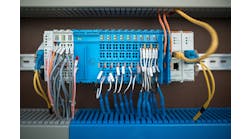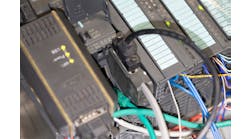The introduction of Ethernet-APL technology earlier this year is an important technology milestone, enabling a new, high-performance paradigm of digital field communications for the process industry.
Its dramatically higher bandwidth promises to enable a new generation of more capable field devices and Industrial IoT solutions hardly yet imagined. And, because it’s based on Ethernet, it promises to unify and dramatically simplify the control and information architecture of tomorrow’s plants.
But even for a greenfield facility, that fully realized tomorrow is only a few years away. A necessarily conservative lot, end users will need to test out the technology in labs, pilot plants and non-critical applications, while device manufacturers must produce a critical mass of the various field devices needed. Meanwhile, most brownfield process plants face decades during which new technologies will coexist with today’s solutions. No one anticipates that otherwise functional systems will be ripped out and replaced with ones based on Ethernet-APL. Instead, Ethernet-APL will have to compete opportunistically with current technologies and present advantages that outweigh the price of change: if adoption requires unfamiliar tools and work processes, those advantages will be harder to come by.
We’ve been here before. Fieldbus, the last effort to fully digitalize field communications, was a technical success but a commercial underachiever. It introduced new complexity that was simply a price too high to catalyze widespread adoption. To carry the chemical reaction analogy one step further, we as an industry must aim to keep the “activation energy” of new technology adoption as low as possible.
Enter HART-IP
While Ethernet-APL is a triumph of technology, offering 10-Mbps, two-wire, powered communications over long distances and in hazardous locations, it’s only part of the puzzle. APL stands for “advanced physical layer,” which means that complementary application protocols are needed to fill out the communications stack. And since it’s Ethernet, we can even use multiple such protocols over the same pair of wires at the same time.
It’s both liberating and potentially confusing to contemplate the coexistence of multiple protocols in the digital field. But it’s just like the network one has at home or in the office. Since it’s Ethernet and Internet Protocol (IP), you can browse websites, send emails, print documents and stream video—each time transparently using a different application-level protocol over a shared Ethernet IP infrastructure.
Similarly, when it comes to the digital field, a range of “industrial Ethernet” networks are likely to play roles depending on the application and industry in question. But when it comes to the configuration, monitoring and diagnostics of process instruments and final control elements—and the process control they enable—one industrial Ethernet protocol stands alone in its ability to carry forward existing tools, work practices and workforce familiarity and to lower the activation energy of adopting Ethernet-APL. And that’s HART, specifically in the form of HART-IP.
HART-IP was first introduced in 2007 as a high-speed Ethernet protocol to communicate HART data collected from WirelessHART gateways. The original HART, in turn, dates back to the 1980s when it was developed and released as an open standard for smart transmitter communications. Uniquely, the original HART protocol still communicates over the 4-20mA analog instrumentation current loops first standardized in the 1950s. Today, tens of millions of 4-20mA analog instruments with HART constitute the vast majority of installed instrumentation around the world. Even today, it dominates shipments of new instruments to the global process industries.
Future-proof evolution
In recent years, the utilization of HART data from existing devices has only continued to increase. For many end users, the primary use case for the 4-20mA version of HART was during device installation and commissioning, after which they turned to handheld communicators for periodic field troubleshooting and calibration.
But booming interest in realizing the benefits of digital transformation has more and more users seeking to continuously expand upon HART data in their instruments. In fact, more than one industrial network infrastructure provider has reported that the Ethernet multiplexers used for such purposes are flying off the shelves. This means that end users are only increasing their investments in the HART ecosystem.
Meanwhile, today’s HART-IP has advanced significantly since it was first introduced. Adding an integrated security model in the latest version of the HART IP standard was key to establishing a proper cybersecurity posture on the next generation of Ethernet field devices. It’s also important to realize that in HART-IP, the 4-20mA analog signal is replaced with secure, high-speed digital transmission of process variables and control instructions. In short, HART functionality is no longer limited to monitoring and diagnostics—with HART-IP it does control, too. Tests performed on Ethernet-APL indicate bandwidth that is more than sufficient for closing the loop on most process control applications. For example, even with 150 devices reporting 20 updates per second over a 10 Mbps subnet, only 30% of available bandwidth was consumed. (Visit fieldcommgroup.org/technologies/HART-IP/explained for more details.)
WirelessHART already is being used to manage data streams from quite sophisticated instruments such as vibration sensors for condition monitoring. Entire frequency waveforms are being communicated via HART-IP, and the core HART data model handles all that detail with aplomb.
But what’s even more special about HART is that the protocol remains consistent across all these architectures—Ethernet-APL, WirelessHART and 4-20mA HART. And that means minimal changes to existing tools plus little training up of plant personnel on new work practices upon adding Ethernet-APL to the mix.
Indeed, the biggest beef against 4-20mA HART has always been speed, making configuration and other tasks both time-consuming and cumbersome. But with HART-IP over Ethernet-APL, it’ll be like someone swapped out your old dial-up modem for a modern WiFi connection. One’s desktop computer, email software and web browser are unchanged; they all work just as before—albeit orders of magnitude faster.
That’s what HART-IP over Ethernet-APL promises: all the advantages of higher bandwidth without incurring the activation energy penalties that often come with technology adoption. And, if someday an even more powerful network platform comes along to complement Ethernet-APL, it’s a safe choice that the proven ability to abstract network particulars from the HART protocol’s data model will work there as well.
Interoperability preserved
Bringing HART along as we move toward an Ethernet-APL future also allows us to preserve what has become industry’s best example of ecosystem interoperability among different suppliers’ devices and systems.
Decades of effort have resulted in Field Device Integration (FDI) technology that helps to ensure proper field device management by the host—including device configuration, replacement, maintenance and diagnostics—that is standardized and usable across all systems, independent of device or system suppliers or vendor-specific tools. Today’s FDI technology even allows instrument makers to create secure, application-specific web apps for their devices.
The HART protocol with Ethernet-APL doesn’t just benefit end users. It also promises to ease the development burden for device manufacturers, who can spend less time on their communication stack and more time figuring out what advanced functionality they can implement with the greater power that Ethernet-APL delivers: from less than 40mW intrinsically safe power with a 4-20mA transmitter to 500mW intrinsically safe power with Ethernet-APL.
Importantly, Ethernet-APL also affords coexistence of application protocols in the same architecture, even over the same pair of wires. This means that using HART-IP to communicate with process instruments and control valves doesn’t impinge on using an alternative protocol for other application domains. For example, if current tools and work processes leverage EtherNet/IP or Profinet to talk with drives and motor control centers, Ethernet-APL teamed with these protocols will make the transition for the personnel responsible for these assets just as easy as it is for the instrumentation and control personnel already familiar with HART.




